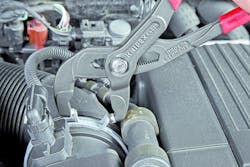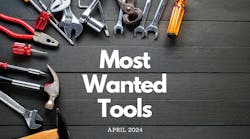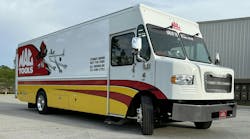Before the advent of fitting disconnect and clamp removal tools, technicians were ill-equipped to remove these components from hoses and lines on a vehicle. Removal of these components often led to frustration, pinched fingers and added vehicle service time.
As a specific example, clamps were oftentimes over-squeezed, deformed or destroyed using traditional pliers, diagonal cutters, vise grips or snips.
“That would obviously damage the clamp and they couldn’t reuse that clamp,” explains Michelle Auge, automotive sales manager, Knipex Tools. “Sometimes it would damage the hose, and they’d have to replace both the hose and the clamp.”
As a fix, technicians were (and sometimes still are) left to replace these constant tension spring clamps with a screw clamp – which may not provide as tight of a seal as the original clamp.
“It’s important for (techs) to know they can reuse the clamps, ahead of time, and have a tool that has the ability to actually reuse these clamps,” adds Beverly Richards, marketing manager, Knipex Tools.
Disconnect and clamp removal specialty tools available today address the needs of technicians by providing a means to quickly and easily remove clamps and fittings on hoses and disconnect lines, without the need to replace components, or to cut and splice replacement lines.
While a technician will oftentimes know what he or she is looking for in terms of the right tool for the application, as a distributor trying to sell these tools to the shop, it can be a matter of knowing what products are available, and what information and resources to provide a customer to make the sale.
Overview of products available
When servicing hoses and lines, technicians need the ability to quickly and easily remove clamps and fittings to access different areas of a vehicle.
Technicians look for the following features when it comes to specialty tools to assist with removing clamps and lines: ease of use, ease of access into tight or difficult-to-reach spaces, and universal applications.
“A lot of times with these components, clamps and fittings are in very tight spots and hard to get to,” explains Rush Mundy, sales director, Cal-Van Tools. “With a lot of the newer cars, things are pushed so tight together to maximize space that if you have a tool that’s maybe a little older and bigger, you can’t get in and remove the disconnect (fittings) and hose clamps.”
Manufacturers of fitting clamp removal tools – such as hose clamp pliers, as well as disconnect sets, have sought to provide technicians with a means to easily and quickly access these areas.
“Technicians should first make sure the kit they are considering is made for the specific vehicle application they have,” says Frank Walker, vice president of marketing, Airsept Inc. “If the fitting is in a difficult-to-access location, the technician must also make sure the kit he or she purchases includes tools that have the appropriate size, angle, or handle design to fit into that space.”
Mayhew, a tool manufacturer of ratcheting hose clamp pliers, recently launched an upgraded hose clamp tool with additional benefits to the technician – including a universal clamping mechanism to service a number of automotive spring clamps and a stronger cable to help minimize the issues of these cable lines fraying or kinking.
Mayhew’s OEM and International Sales Manager Deb Selicious advises it’s important to review the thickness of the hose clamp pliers cable, to ensure the pliers will hold in place and complete the intended task. She also encourages techs to review the size range of the clamps the tool will remove, and ensure the product has an ergonomic grip for easier handling. Ratcheting hose clamp pliers in particular provide technicians with access to spring-lock clamps that may otherwise be very difficult to access with a traditional hose clamp pliers.
Mundy confirms the development of the hose and line removal specialty tool category is often reactionary, based on the new vehicle component layouts and different clamps and fittings introduced to the market.
“Technological trends in these tools are driven by what new connector designs are on the vehicles each new model year,” Walker adds.
While there is no widely adopted standardization for design and sizing on different clamps and fittings, technicians employ a basic understanding of sizing ranges for each line type. For instance, the smallest-sized disconnect tools are used for fuel lines, followed by HVAC, which includes air conditioning and heater lines, then transmission or transcooler lines. Sizes range from 5/16” up to 7/8” and beyond, for heavy duty applications.
Jon Bielfeldt, vice president of Lisle Corp., explains one of the reasons behind the varied line sizes, specifically for disconnect sets.
“It has more to do with the coupling style of how you put those lines together,” he says. “Back in the day, it used to be a band-clamp that you snugged up with a screwdriver. Now, they’re typically a quick-connect style fitting of some sort.”
Also with disconnect sets, users will find a vast array of shapes, sizes and materials in master kits. It goes without saying shapes and sizes are designed for specific lines and difficult areas to access. But what about the materials used for manufacturing these tools?
Bielfeldt confirms it’s mostly based on price point – a plastic tool can have the same functionality as a metal tool, while being less expensive. This can translate to more sales for the distributor as well.
“If you use the right plastic material, it’s resistant against fuels and other solvents, and you’ll end up saving the customer a whole lot of money too,” Bielfeldt says. “They’re more likely than to buy a full set of (disconnect tools) – maybe six sizes – instead of just buying the one size that they might have the job for at that time.”
Mundy agrees about the use of plastic materials in some instances.
“Metal is associated with better durability, but in some cases, it’s not cost-effective to make some of these tools in metal molds,” Mundy says. “Plastic will work just fine.”
That’s not to say metal materials aren’t sometimes a better option for some applications. Bielfeldt adds there are some instances where a metal tool is still ideal. For instance, if the tool is required to be very thin, to fit underneath a certain component.
Addressing changing technician needs
In some cases, the tools introduced to market will be so specialized they only work on one type of clamp or fitting. Tool manufacturers are frequently introducing products to address these specific needs. In addition, as new clamps and fittings are used with vehicle manufacturing, technicians must figure how to access these areas of the vehicle with new tools.
Two examples of newer vehicle component technologies include click clamps and Jiffy-tite fittings.
Originally found only on high-end European vehicles, click clamps are gaining popularity among automakers. These clamps are currently found mostly in fueling systems and cooling systems, but are becoming more widely used each model year.
Knipex Tools offers a set of hose clamp pliers for click clamps to address the same requirements as traditional hose clamp pliers - such as universal access and adjustable grips and tips - while allowing the technician to access, remove and reuse this unique style of clamp.
“The rotatable tips on the tool rotate at a 90-degree angle for better access and ease of removal,” explains Knipex’s Auge.
In addition, Auge says, this tool works on eight different types of click clamps on the market today.
Lisle’s Bielfeldt explains that component manufacturers, as is the case of Jiffy-tite, sometimes work with tool companies to develop a tool used for their specific products. In this case, Jiffy-tite fittings were originally developed for the racing industry because they provide a very secure connection.
Now showing up on consumer vehicles, Lisle Corp. has worked with the component manufacturer to develop a tool to remove these fittings. Specifically, the 3/8” size Jiffy-tite fitting has been used on the transmission oil cooler lines for lower front-mounted radiators such as GM pickups, Bielfeldt says.
He emphasizes many techs may not have yet seen this fitting while working on vehicles, which can present an unforeseen issue.
“Last year, we introduced an 8mm size for some Cadillac applications.” Bielfeldt says. “It’s been fairly small in its use and sales at this point. But, in talking to Jiffy-tite (in late 2016), they said there are millions of those 8mm fittings that are going to start going on vehicles this year.”
Tips for selling
Many times, a customer just needs to see the tool in action. Just as the tool manufacturers will have visual aids on-hand at their booth to display tools during a trade show, distributors can create their own displays by purchasing different sized hoses, lines, clamps, fittings or couplings from an auto parts store, to keep on the truck.
“When we do demos, when we’re at a show, we have this display that’s a maze of hoses with various clamp sizes on it,” Mayhew’s Selicious says. “That’s what we use to demonstrate how to use these (tools) at a show.”
These demos can also be small enough to carry into the shop to show customers.
“Use spare radiator hoses and put different sized clamps on them, to have a small demo piece that they can carry around and actually show how to use the tool,” Knipex’s Richards adds.
If creating a physical demonstration piece isn’t doable, a visual aid such as a printed photo or application video playing on the truck can still be helpful.
Another suggestion and unintended outcome of larger sets of disconnect tools, or master disconnect sets, is using this set as a merchandising kit.
“It may be hard to sell that whole kit to a customer, but what a lot of distributors do is sell the tools out of the kit as [customers] need them, because that’s a great place to have a home to go to, and pick out all the different tools that are available,” says Lisle’s Bielfeldt.
Not only do customers have one location where they can view a number of different products, this kit allows the distributor the ability to sell one-off SKUs and replace them as needed, if a customer only requires one product from the kit.
While demonstrations prove helpful as a visual aid, it sometimes comes down to asking the right questions to get a conversation started.
“When you are a mobile distributor, you carry hundreds and hundreds of tools on your truck,” Cal-Van Tools’ Mundy says. “It’s hard to necessarily figure out which one a customer needs. If you walk into a shop and say, ‘Have there been any trouble spots for you?’ or ‘Have there been any lines or hoses you’ve had trouble getting off, and the tool doesn’t fit just right?’ A simple question like that can either trigger a new tool for that particular mobile tool truck (to stock), or, the distributor may already have something available that the customer didn’t know about.”


